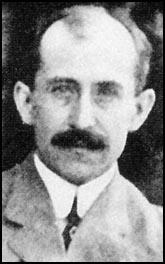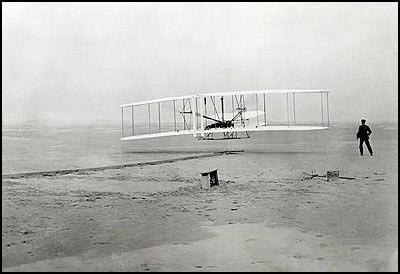Orville Wright

Orville Wright, the son of a United Brethren Church bishop and the brother of Wilbur Wright, was born in Dayton, Ohio, in 1871. When Orville was seven and Wilbur was eleven, their father gave them a model monoplane that had been designed by Alphonse Pénaud. They were fascinated by the toy and told themselves that one day they would make an aeroplane that would fly.
In 1888 Orville started a printing business. Wilbur joined him and together they designed and built a new printing press. Four years later the brothers sold their printing business and opened a bicycle shop to sell and repair bicycles in Dayton, Ohio. The shop was a great success as both brothers were talented engineers.
In August, 1896, the brothers read about the death of Otto Lilienthal in a flying accident. Lilienthal, a German engineer, had for many years been building flying machines. Wilbur Wright later wrote: "The brief notice which appeared in the telegraphic news at the time aroused a passive interest which had existed from my childhood." Soon afterwards the Wright brothers acquired a copy of Lilienthal's Bird Flight as a Basis for Aviation.
They also read Etienne-Jules Marey's book, The Flight of Birds. Orville Wright commented: "Learning the secret of flight from a bird was a good deal like learning the secret of magic from a magician". According to Wilbur Wright "we soon passed from the reading to the thinking stage, and finally to the working stage."
Percy Pilcher, another figure trying to develop a flying machine was killed on a glider flight in October 1899. This convinced the Wright brothers to concentrate on building kites controlled from the ground. These kites had controls for warping the wings to achieve control of direction and stability.
By 1901 the Wrights had developed a successful glider and broke the world record by reaching 389 feet (118 m). Not satisfied with this the following year one of their gliders went even higher and achieved 600 feet (183 m). They now decided to build an aeroplane. To help them in this they moved to Kitty Hawk, an isolated fishing village in North Carolina. At Kitty Hawk they had miles of empty sand dunes to carry out their experiments. The brothers also built a small wind tunnel so they could test various wing designs and cambers.
The Wrights also decided to develop their own engine and propeller. With the help of their wind tunnel, they were able to carry out research that enabled them to develop a propeller that converted 66 per cent of the engine's power into forward thrust. Their experiments revealled that the propeller tilted the aircraft in the direction opposite to the way it turned. Therefore the Wrights used two propellers, turning in opposite directions.
Samuel Pierpont Langleyof the Smithsonian Astrophysical Observatory was also busy developing a flying machine. Powered by a gasoline engine, the Aerodrome attempted to make its first flight on 7th October, 1903. The Aerodrome crashed soon after leaving the launch pad on the Potomac River. The front wing was badly damaged but this was repaired and a second attempt was made on 9th December. This time the rear wing and tail completely collapsed during the launch.
Wilbur and Orville Wright watched these developments with interest. They did not allow Samuel Pierpont Langley's failure to damper their own enthusiasm to create a flying machine. On 17th December, 1903, the brothers were ready to test out the areoplane they called Flyer I. Orville took the controls and the flight only lasted 12 seconds. However, the aircraft travelled 118 feet (36 m), 10 feet (3 m) above the sand. The brothers made a couple more flights and a few hours after Orville's first flight, Wilbur managed to clear 852 feet (260 m) in 59 seconds. After he landed a gust of wind caught the Flyer I and blew it over, damaging it so badly that it never flew again.
There might have been doubts about the truth of these test runs. However, as well as aviators, the Wright brothers were also interested in photography and had arranged for these flights to be captured on camera. Despite this evidence other aviators, especially in France, refused to believe that the Wright brothers had made the first ever powered flight. Instead they preferred to believe that Clement Adler had done this in 1897.
The Wright brothers now began negotiations with various governments around the world. Two years later they sold their designs for the Flyer I for $30,000 (about $600,000 in today's money). The Wright brothers now returned to manufacturing areoplanes. In October, 1905, the Flyer III stayed in the air for 38 minutes.
In 1908 the brothers produced the Wright Model A. This was a two-seater with an improved control system. It had a much more powerful engine and could reach a speed of 44 mph (71 kpm). However, on 17th September, the brothers had their first plane crash. Orville Wright was seriously injured and his passenger, Thomas Selfridge, was killed.
Wilbur took the machine to France and at a demonstration at the military field at Camp d'Auvours, set an endurance record of 2 hours 20 minutes 23 seconds. It also set an altitude record of 362 feet (110 m). As a result of the tests the brothers were able to sell construction licences for the Wright Model A to Britain, France and Germany.
After the death of Wilbur Wright from typhoid fever in 1912, Orville lost interest in aviation and sold the Wright Company in 1915.
Orville Wright died in 1948.

the Flyer in its first flight on 17th December, 1903
Primary Sources
(1) Julian Borger, The Guardian (18th December, 2003)
The original Wright Flyer got off the ground for 12 seconds and flew for barely 35 metres. But this was still 12 seconds and 35 metres more than an exact replica managed yesterday, during initial attempts to re-enact the Wright brothers' feat. Determined to mark the centenary of the first flight, hundreds of Americans gathered at the spot on the Outer Banks of North Carolina where the first long hop took place.
The occasion, however, quickly became a re-enactment of the setbacks that the pair of bicycle mechanics faced a hundred years ago.
One attempt to fly the replica of the Wright Flyer, in front of President Bush and some of the surviving greats of aviation history, had to be postponed due to torrential rain.
A later attempt to get off the ground failed because of a lack of headwind, and the wood and canvas contraption flopped on to the muddy fields at Kill Devil Hills, near the town of Kitty Hawk.
Enthusiasts were still trying to get the replica off the ground last night.
